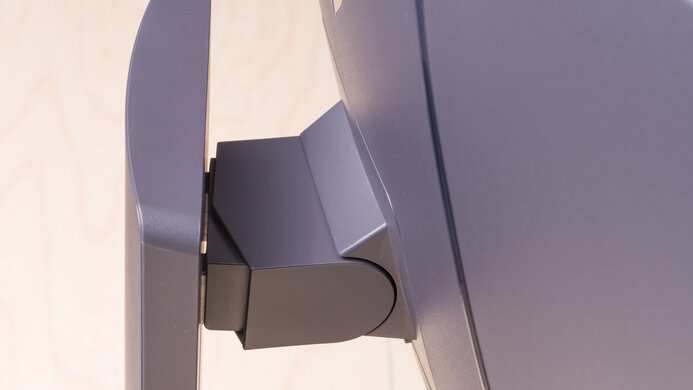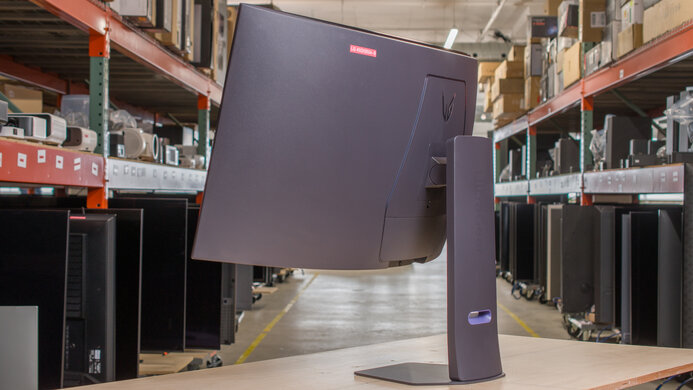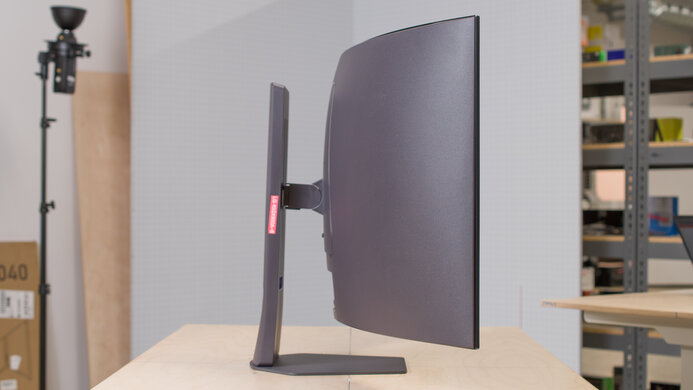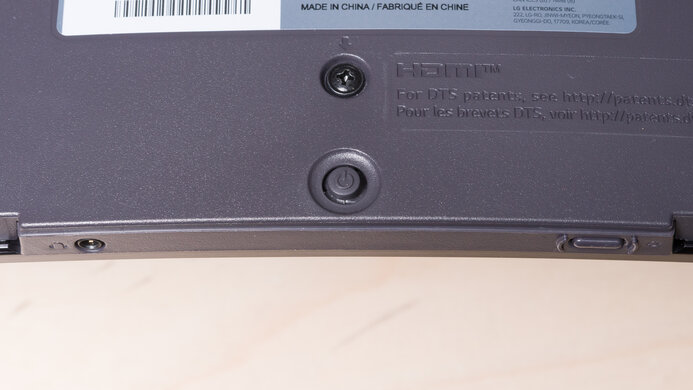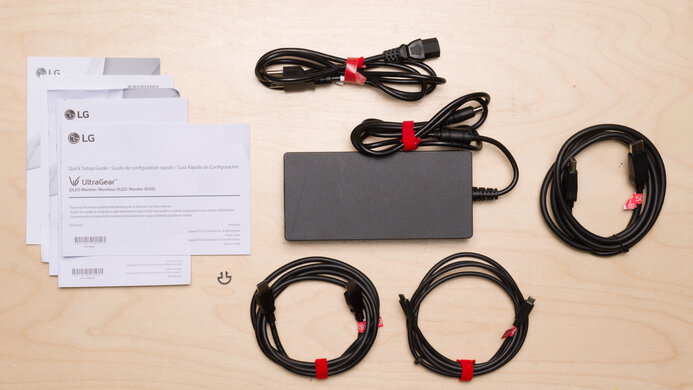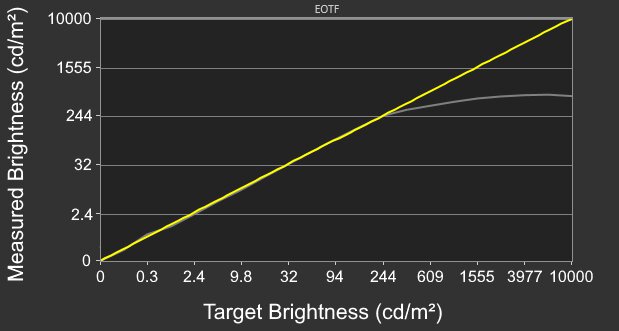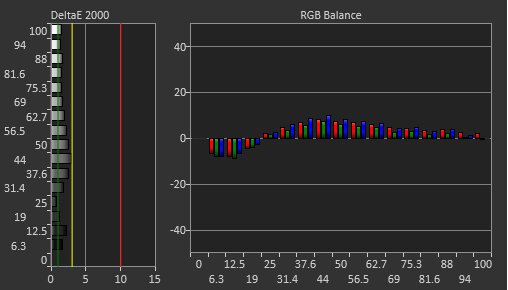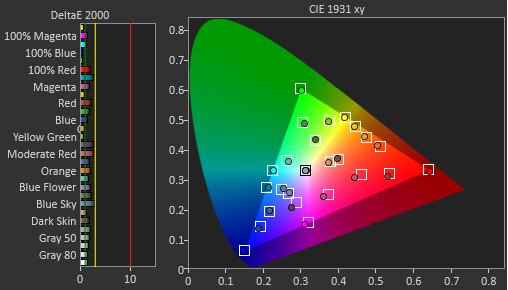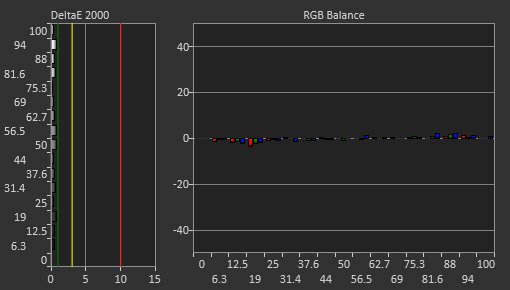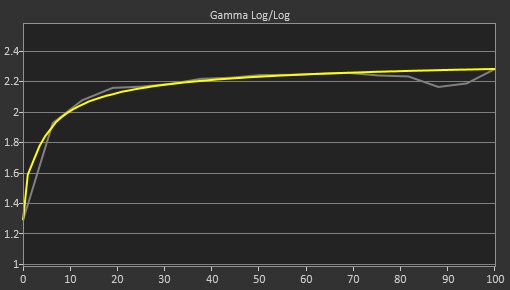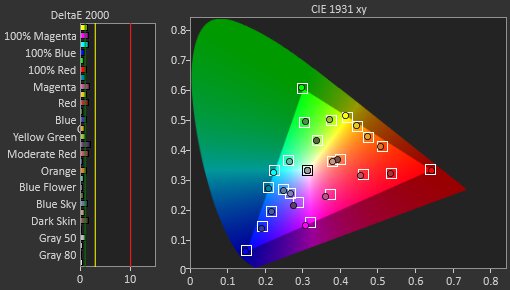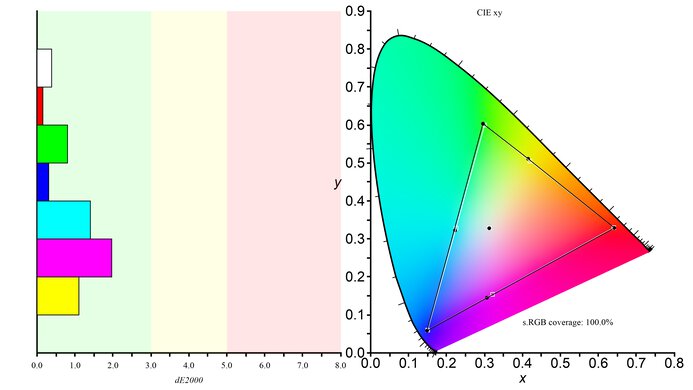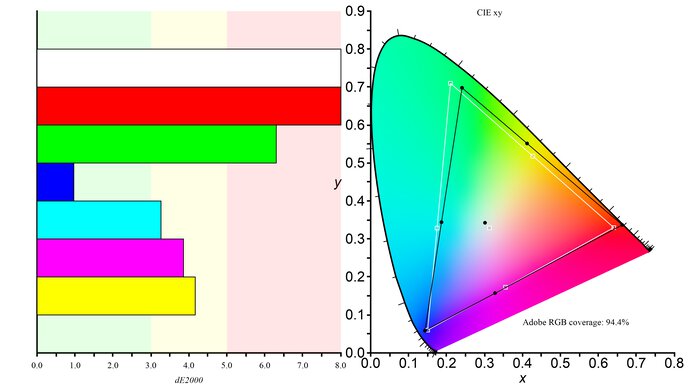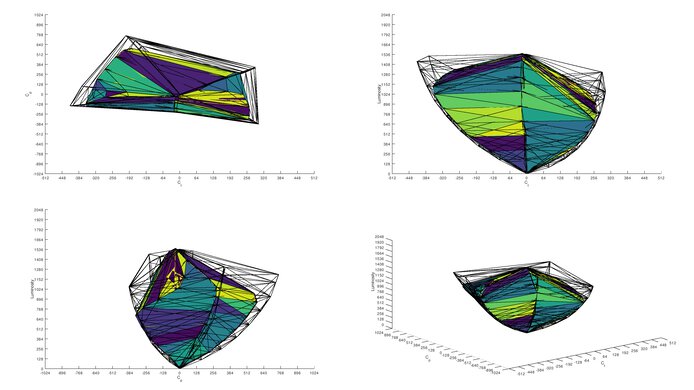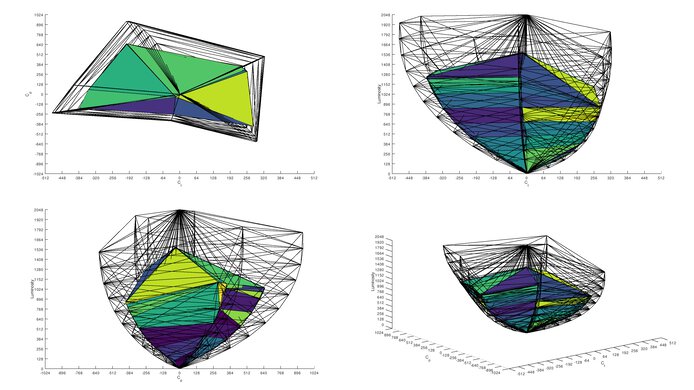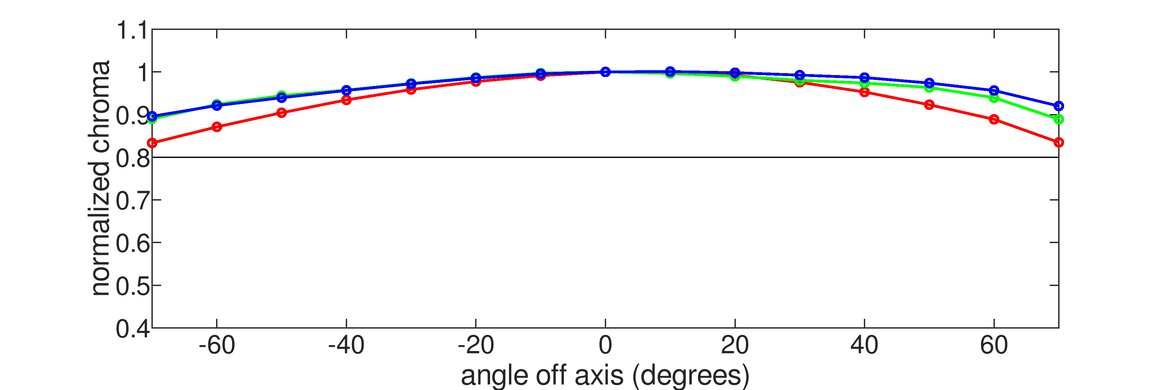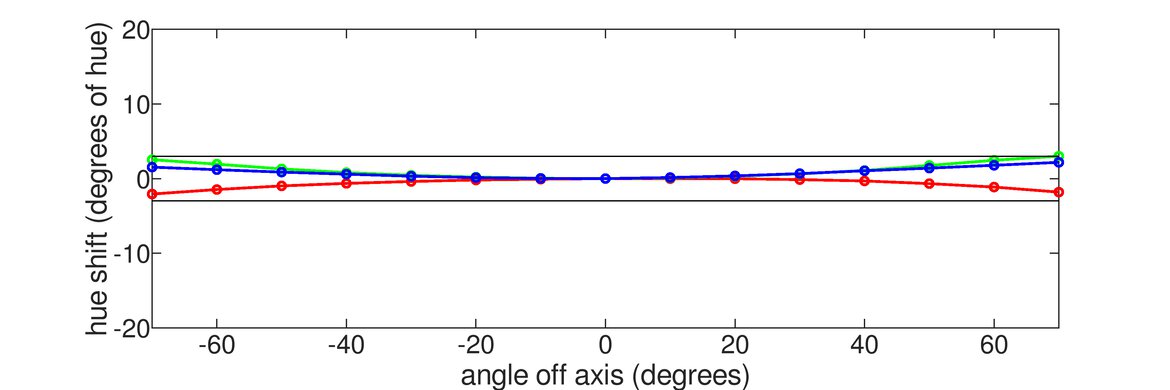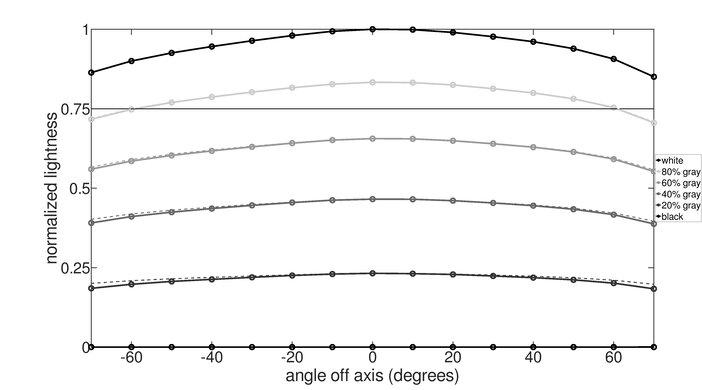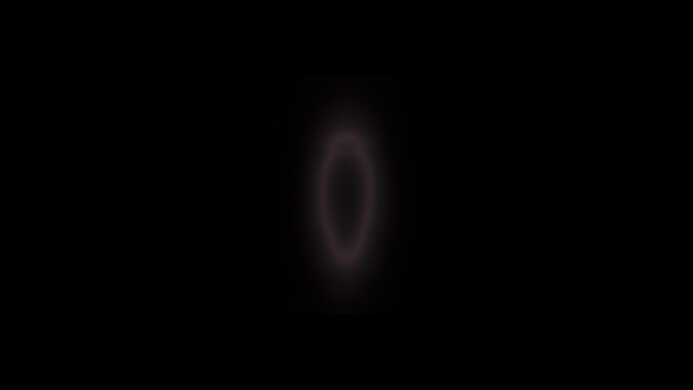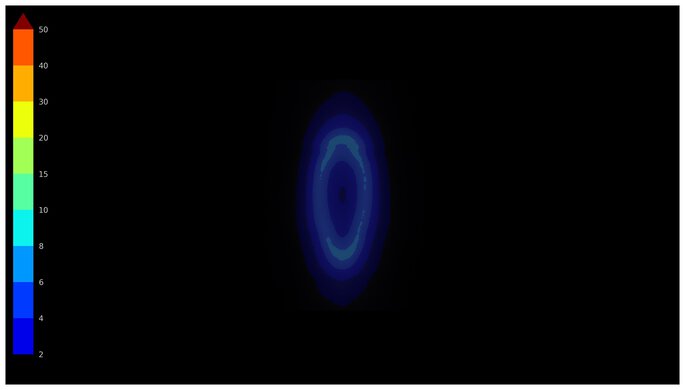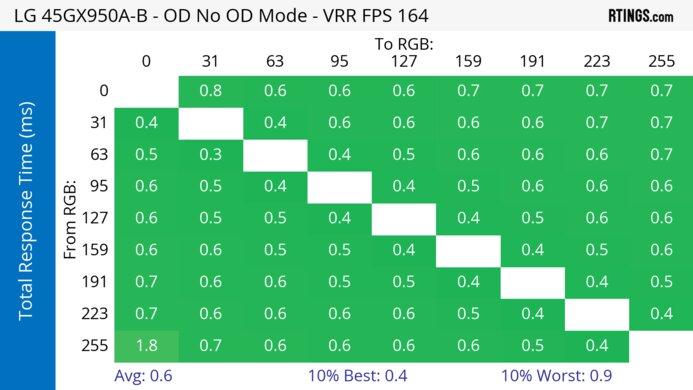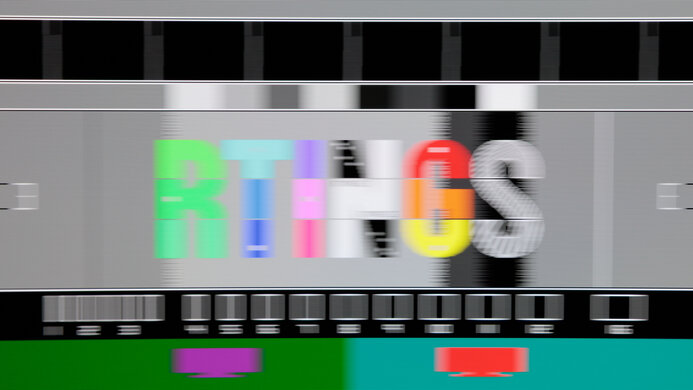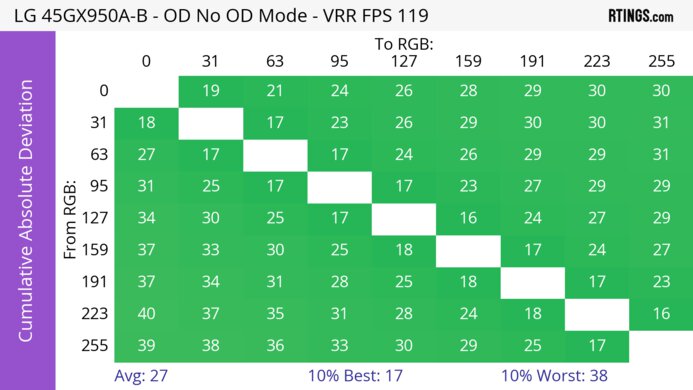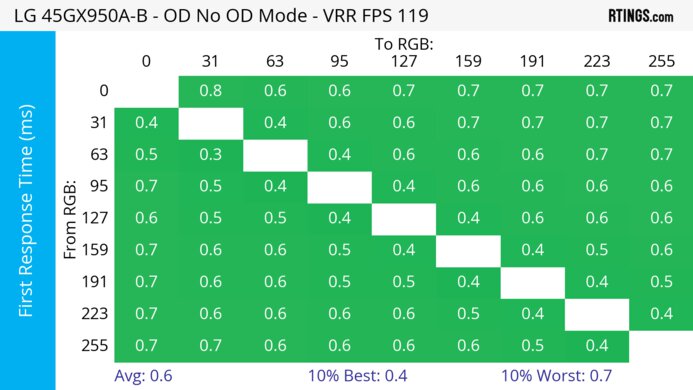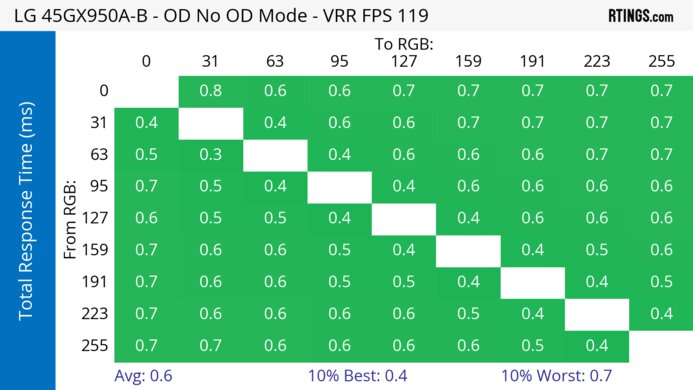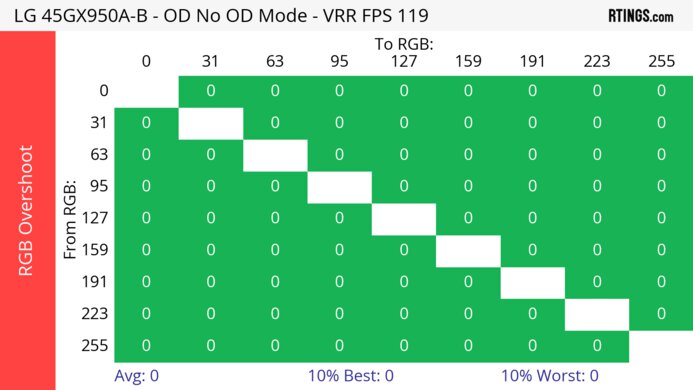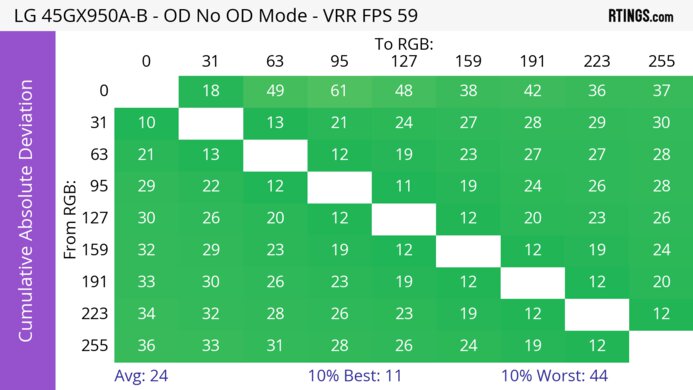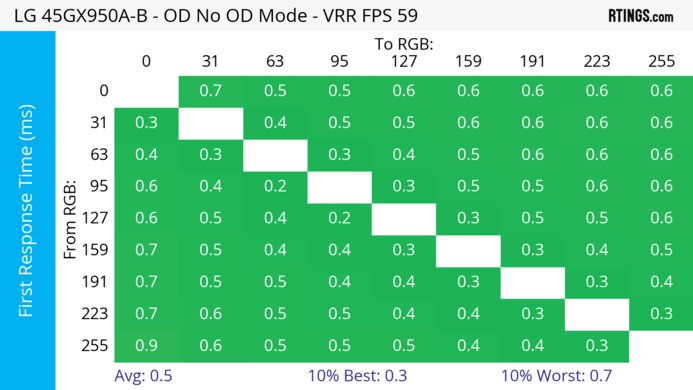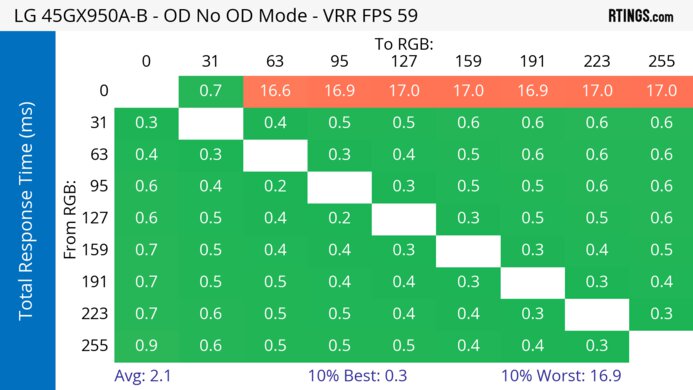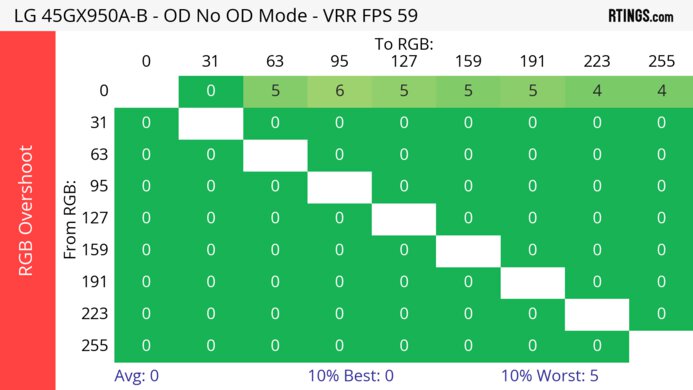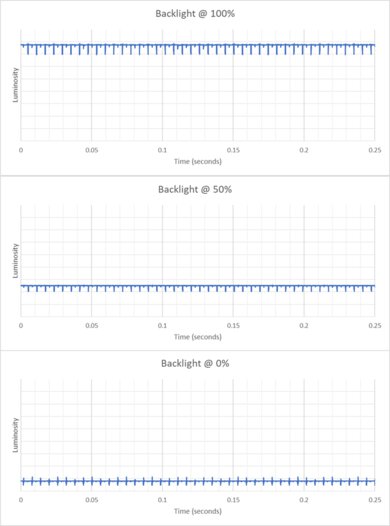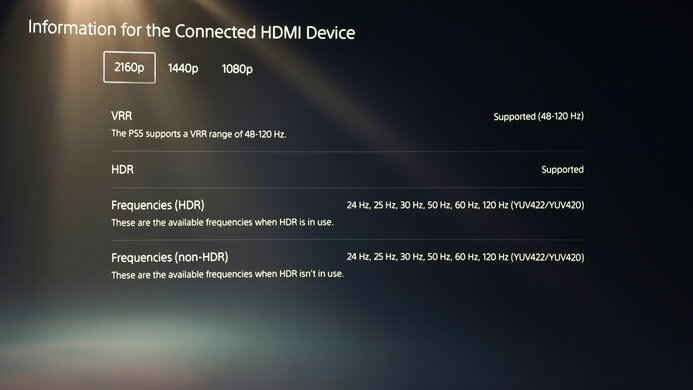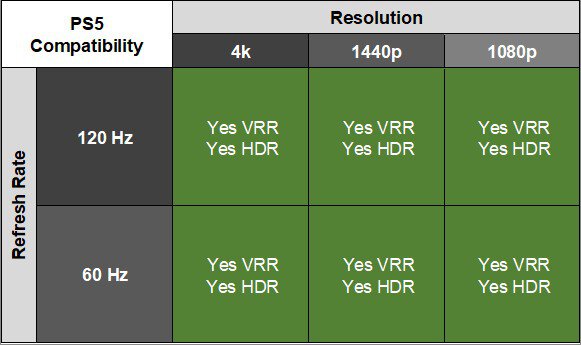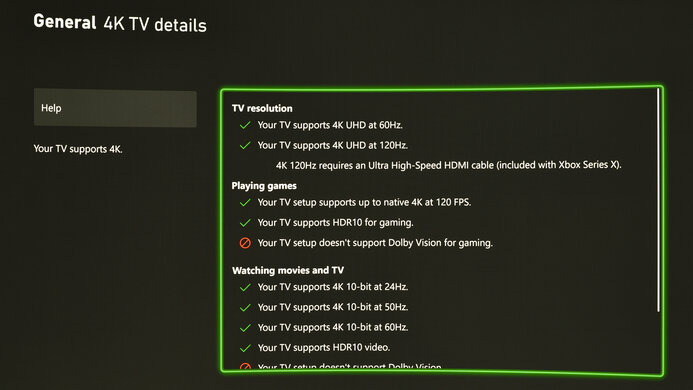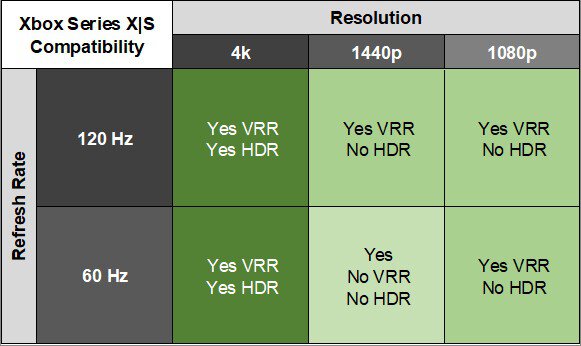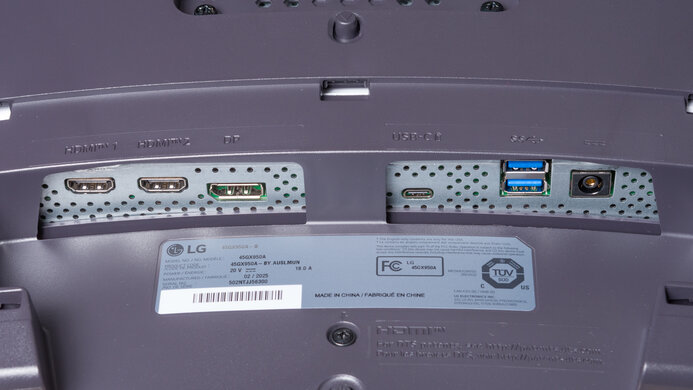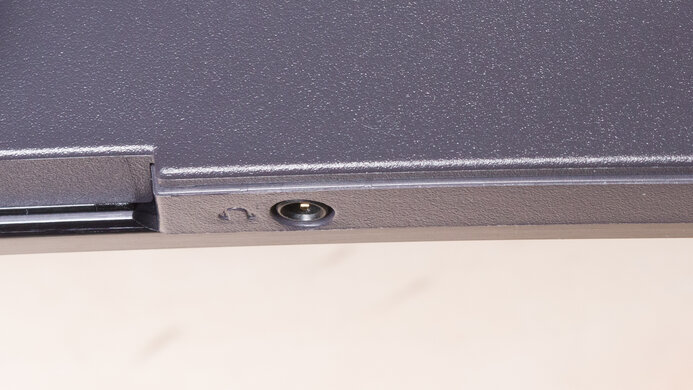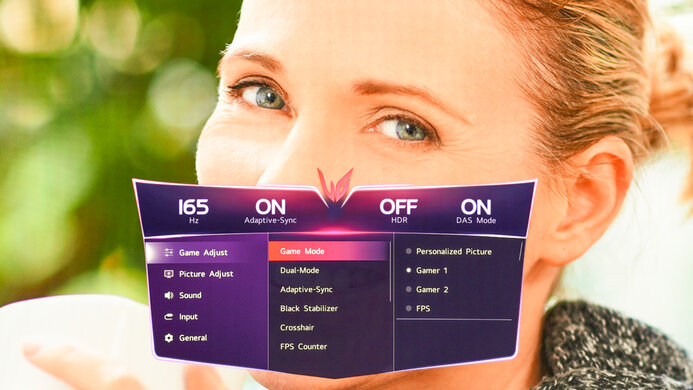The LG 45GX950A-B is a premium ultrawide gaming monitor. It's the first 45-inch WOLED display with a 5120x2160 resolution, also known as 5k2k, resulting in a pixel density of 125 PPI. Featuring an 800R curved screen, it sits alongside the LG 45GX990A-B, which has a bendable screen, and it's higher-end than the LG 45GX90SA-B and older monitors, like the LG 45GR95QE-B, which have a lower resolution. It has a native 165Hz refresh rate, and one of its main advantages is the Dual-Mode feature that lets you switch the aspect ratio, resolution, and refresh rate, most notably to a 2560x1080 resolution with a 330Hz refresh rate. It has other perks, like VRR support, HDMI, and DisplayPort 2.1 bandwidth to take advantage of modern PCs and consoles, and it also has DisplayPort Alt Mode over USB-C port. Plus, LG advertises that in the United States, it comes with a two-year warranty, including the OLED panel, but this can vary between regions.
Our Verdict
The LG 45GX950A is fantastic for PC gaming. It has a Dual-Mode feature that allows you to choose between a 5120x2160 resolution with a 165Hz refresh rate or a 2560x1080 resolution with a 330Hz refresh rate, so it's versatile for different types of games you may play. It even has high-bandwidth HDMI and DisplayPort inputs and supports any common VRR format. Gaming feels responsive, thanks to its low input lag in any mode, and it has incredibly sharp motion handling. It also delivers excellent picture quality with deep and inky blacks in dark rooms, no blooming around bright objects, and highlights that pop. However, while it displays a wide range of colors in HDR, it struggles to properly display bright colors.
Dual-Mode feature between 165Hz and 330Hz refresh rates.
Near-infinite contrast ratio in dark rooms.
Small highlights pop in HDR.
Incredibly sharp motion.
Large screen with high native resolution.
Bright colors aren't very vivid.
Noticeable VRR flicker with changing frame rates.
The LG 45GX950A is incredible for console gaming. It has a high 5120x2160 resolution for sharp and detailed images, but because gaming consoles don't support ultrawide gaming, you'll see black bars on the sides. It still provides a fantastic gaming performance with low input lag and a near-instantaneous response time, resulting in sharp motion. Its picture quality is also excellent, as blacks are deep and inky in dark rooms without any blooming, and highlights pop against the rest of the image in HDR. However, it doesn't get as bright in SDR, so it struggles to fight glare in a well-lit room.
Near-infinite contrast ratio in dark rooms.
Small highlights pop in HDR.
Incredibly sharp motion.
Large screen with high native resolution.
Supports almost any signal from a PS5 or Xbox Series X|S.
Bright colors aren't very vivid.
Consoles don't support ultrawide signals.
The LG 45GX950A is good for office use, with certain limitations. Its 45-inch screen provides a ton of screen space to work with, and it has a high resolution for sharp text clarity. However, there are some fringing issues around text, and text looks a lot less sharp if you use its Dual-Mode feature, which lowers the resolution. The monitor also has great reflection handling, and it's easy to see the screen if you have some lights around, but it doesn't get bright enough to fight a ton of glare in SDR. There are some downsides to using it, though, as its aggressive curve may take some time getting used to, and it risks burn-in with constant exposure to the same static elements over time.
Large screen with high native resolution.
Sharp text clarity with Dual-Mode off.
USB-C port with 90W of power delivery.
Great reflection handling.
Doesn't fight glare in SDR.
800R curve may take time getting used to.
Risk of burn-in.
The LG 45GX950A is amazing for content creation. It delivers excellent picture quality thanks to its near-infinite contrast ratio in dark rooms, resulting in deep blacks, and there isn't any blooming around bright objects either. It also displays a wide range of colors in HDR and makes small highlights pop, but it struggles to properly display bright colors. It even comes with a dedicated sRGB mode that has fantastic accuracy before any sort of calibration. There are some downsides, though, as it doesn't get bright enough in SDR to fight a ton of glare. While it has a big enough screen for multitasking, you may need some time to get used to its aggressively curved display. Unfortunately, it also risks burn-in with constant exposure to the same static elements over time.
Near-infinite contrast ratio in dark rooms.
Small highlights pop in HDR.
Large screen with high native resolution.
sRGB mode with accurate colors before calibration.
Doesn't fight glare in SDR.
Bright colors aren't very vivid.
800R curve may take time getting used to.
Risk of burn-in.
The LG 45GX950A has decent brightness. It gets brightest in HDR as it fights glare and makes small highlights pop, but it's dimmer in SDR.
Small highlights pop in HDR.
Doesn't fight glare in SDR.
The LG 45GX950A has a near-instantaneous response time for incredibly sharp motion.
Incredibly sharp motion.
The LG 45GX950A has excellent HDR picture quality. It displays deep, inky blacks in dark rooms without any blooming. It also displays a wide range of colors, but it struggles with properly displaying bright colors.
Near-infinite contrast ratio in dark rooms.
Displays a wide range of colors.
Bright colors aren't very vivid.
The LG 45GX950A has outstanding SDR picture quality. It has a near-infinite contrast ratio in dark rooms, resulting in deep blacks, and it displays a wide range of colors.
Near-infinite contrast ratio in dark rooms.
Displays a wide range of colors.
The LG 45GX950A has fantastic color accuracy. It has a dedicated sRGB mode that's accurate before any sort of calibration, but calibrating the monitor improves the accuracy even further.
sRGB mode with accurate colors before calibration.
Some pre-calibration gamma issues.
Performance Usages
Changelog
- Updated Nov 10, 2025: We've converted this review to Test Bench 2.1.1. We removed the Vertical Viewing Angle test.
-
Updated Oct 27, 2025:
We updated the Max Refresh Rate over HDMI and DP to reflect the max refresh rate at its native resolution, for consistency with other reviews.
-
Updated Jun 13, 2025:
We updated text throughout to match the new and updated tests with Test Bench 2.1, including in the Verdict section.
- Updated Jun 13, 2025: We've converted this review to Test Bench 2.1. This includes new tests for Direct Reflections, Ambient Black Level Raise, and Total Reflected Light. You can see all the changes in the changelog.
Check Price
Differences Between Sizes And Variants
We bought and tested the 45-inch LG 45GX950A-B, and the results are valid for this model only. It comes with a fixed 800R curve, but there's also the similar LG 45GX990A-B, which has a bendable screen. There are other ultrawide OLEDs in LG's UltraGear lineup, and you can see the differences between them below.
| Model | Size | Refresh Rate | Resolution | Curve | Smart OS |
|---|---|---|---|---|---|
| 45GX950A-B | 45" |
165Hz (native) 330Hz (Dual-Mode) |
5120x2160 (native) 2560x1080 (Dual-Mode) |
800R | No |
| 45GX990A-B | 45" | 165Hz (native) 330Hz (Dual-Mode) |
5120x2160 (native) 2560x1080 (Dual-Mode) |
0-900R | No |
| 45GX90SA-B | 45" | 240Hz | 2560x1440 | 800R | Yes |
Our unit's label indicates it was manufactured in February 2025. We tested it with firmware (3.01, 4.23.16, 2.04).
Popular Monitor Comparisons
The LG 45GX950A-B is a 45-inch ultrawide OLED gaming monitor. With a Dual-Mode feature that switches it between a 5120x2160 resolution and 165Hz refresh rate or a 2560x1080 resolution with a 330Hz refresh rate, it's unique in the monitor market. There aren't other 45-inch monitors with this same feature, so it doesn't have any direct competition, but this means it's more versatile for different types of games than other large ultrawide displays, like the LG 45GR95QE-B or the Samsung Odyssey OLED G9/G95SC S49CG95. It has everything you'd expect in a high-end gaming monitor, like sharp motion, high-bandwidth ports, and incredible picture quality with a high resolution, deep blacks, and bright highlights. That said, this is also a very expensive monitor, and it's only something to consider if you're going to take advantage of its Dual-Mode feature and want such a large screen. If not, there are other ultrawide OLEDs you can consider for less, like the LG 34GS95QE-B.
Also see our recommendations for the best 34-49 inch monitors, the best ultrawide gaming monitors, and the best LG monitors.
The Samsung Odyssey OLED G9/G95SC S49CG95 and the LG 45GX950A-B are both ultrawide OLED gaming monitors. The main differences between them come down to their sizes and resolutions, as the Samsung is a 49-inch super ultrawide monitor with a 5120x1440 resolution and 240Hz refresh rate. However, the LG is a 45-inch ultrawide monitor, so it's more narrow than the Samsung, and it has a higher 5120x2160 resolution for more detailed images. Although its native 165Hz refresh rate is lower than that of the Samsung, it has a Dual-Mode feature that switches to a 330Hz refresh rate with a lower resolution. This means that choosing one over another comes down to the size and refresh rate that you want. However, the Samsung also has a QD-OLED panel with more vivid colors than the LG.
The LG 45GX950A-B and the Samsung Odyssey Neo G9/G95NC S57CG95 are both large ultrawide gaming monitors. The Samsung has a bigger 57-inch screen with a higher resolution, and it also offers more horizontal screen space thanks to its super ultrawide aspect ratio. The Samsung even has a higher 240Hz refresh rate than the LG's native 165Hz refresh rate, but the LG has a Dual-Mode feature to switch it to a 330Hz refresh rate with a lower resolution. This means the LG is the better choice if you want a higher refresh rate. The LG also has much better picture quality thanks to its OLED panel, as it displays deep and inky blacks without any blooming, but the Samsung gets brighter.
The LG 45GX950A-B is a newer version of the LG 45GR95QE-B, with a few new features. The main difference is that the 45GX950A-B has a higher resolution for more detailed images, and even though it has a lower native refresh rate, it has a Dual-Mode feature that switches it to a 330Hz refresh rate with a lower resolution. This means that the 45GX950A-B is more versatile for different types of games. The 45GX950A-B also has a few added perks, like DisplayPort 2.1 bandwidth and a USB-C port with 90W of power delivery.
The LG C5 42 OLED and the LG 45GX950A-B are both large OLED displays with a few differences. The C5 is a small TV that's popular to use as a monitor, so it has many features that are typical of TVs, including a built-in smart system, eARC/ARC audio passthrough, and a processor. The 45GX950A-B has more typical monitor features, like a Dual-Mode that switches its native 5k2k resolution and 165Hz refresh rate to a 1080p resolution and 330Hz refresh rate. Although they both have WOLED panels, there are a few differences, as the C5 gets brighter in HDR, while the 45GX950A-B has a dedicated sRGB mode that results in better accuracy before calibration. Overall, the C5 is the better choice if you want a small TV that you can use as a monitor, while the 45GX950A-B is the better choice if you want an ultrawide that you're going to use more like a typical monitor.
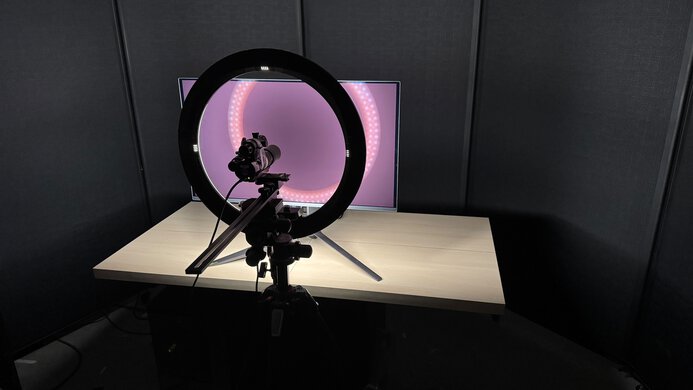
We buy and test more than 30 monitors each year, with units that we buy completely on our own, without any cherry-picked units or samples. We put a lot into each unbiased, straight-to-the-point review, and there's a whole process from purchasing to publishing, involving multiple teams and people. We do more than just use the monitor for a week; we use specialized and custom tools to measure various aspects with objective data-based results. We also consider multiple factors before making any recommendations, including the monitor's cost, its performance against the competition, and whether or not it's easy to find.
Test Results
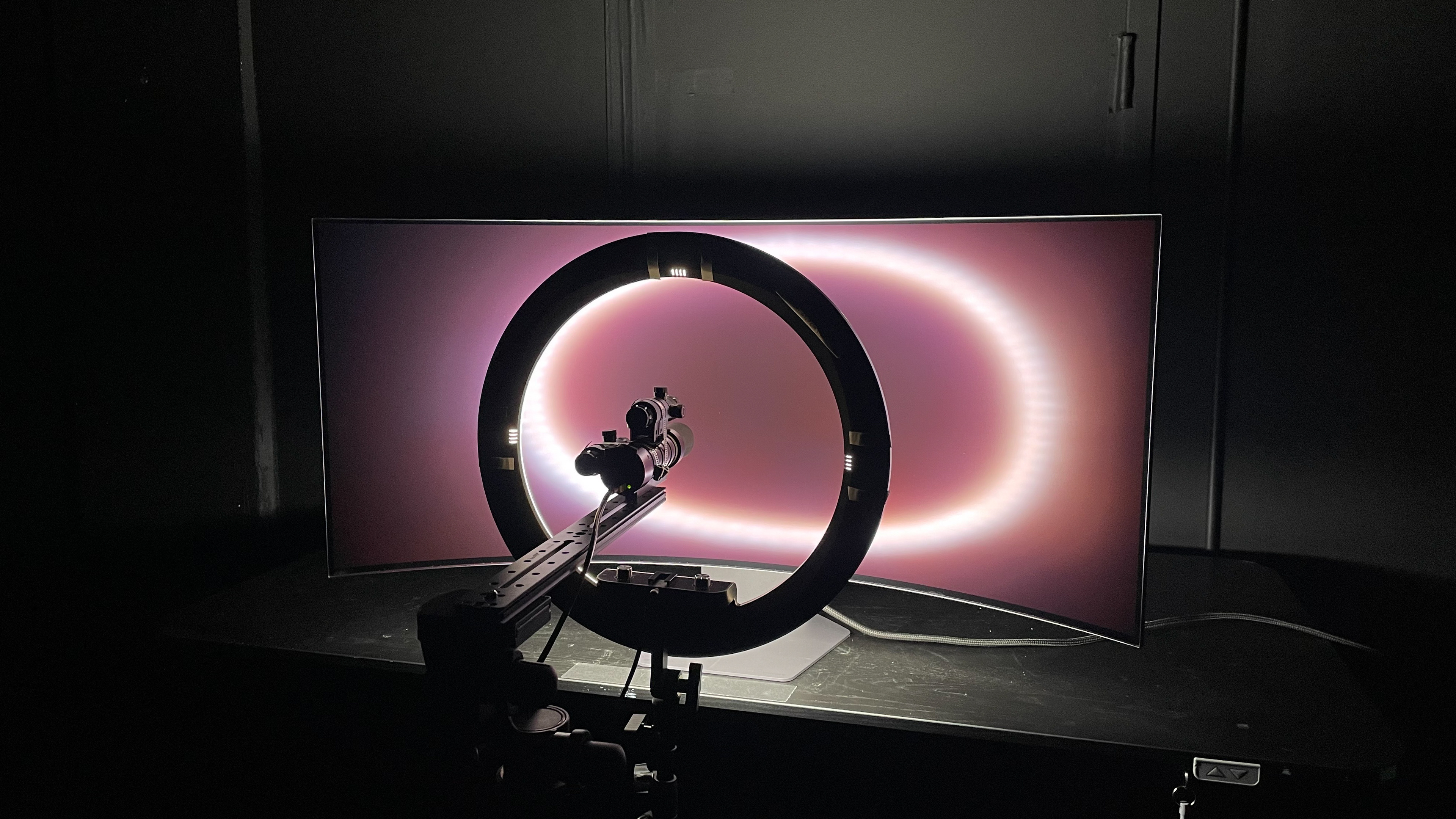
The build quality is excellent. It's well-made, and the plastic materials don't flex easily. The underneath of the base of the stand is metal, but it doesn't prevent all wobble, which is expected from a monitor of this size. Although there aren't many openings for ventilation, the monitor doesn't get significantly hot. There is also no audible fan noise or coil whine either.
The ergonomics are disappointing. Each of its adjustments has a limited range, except for the height adjustment. Luckily, adjusting the screen on the stand feels smooth. It also features a cutout for cable management.
The base of the stand doesn't take up much space, and while it holds the screen well, there's still wobble. The thickness measurement is from the side of the screen to the back of the stand, and the thickness from the center of the screen to the back is 6.7" (17.0 cm).
The thickness measurement is from the side of the screen to the back, and the thickness from the center to the back is 2.0" (5.0 cm).
The LG 45GX950A doesn't have a backlight, so it doesn't require a local dimming feature. However, with a near-infinite contrast ratio, there isn't any blooming around bright objects, and it's the equivalent of a perfect local dimming feature. We still film these videos on the monitor so you can see how the screen performs and compare it with a monitor that has local dimming.
Settings
- Game Mode: Gamer 1 (after calibration)
- Brightness: 100
- Peak Brightness: High
- Dual-Mode: Off (Full Wide)
- Smart Energy Saving: Off
- OLED Screen Move, OLED Screen Saver, and OLED Image Cleaning: Off
The SDR brightness is decent. While it gets bright if you have a small area of the screen displaying bright content, like a non-maximized window, it doesn't maintain this high brightness with most content. This means visibility is an issue in really bright rooms.
The change in brightness between different content can also be distracting, and if that bothers you, it's better to set Peak Brightness to 'Off' for a more consistent brightness. You should also set it to 'Off' if you want the lowest minimum brightness possible.
The brightness in the 'On (Full Wide)' Dual-Mode, which is the 2560x1080 @ 330Hz mode, is also similar, but it gets brighter in the Real Scene test (260 cd/m²) and with the 2% peak window (422 cd/m²).
Settings
- Game Mode: Gamer 1
- Brightness: 100
- Peak Brightness: High
- Dual-Mode: Off (Full Wide)
- Smart Energy Saving: Off
- OLED Screen Move, OLED Screen Saver, and OLED Image Cleaning: Off
The HDR brightness is decent. It gets brightest with small highlights, so they really pop against the rest of the image. Although it can't maintain this brightness with larger content, it's still bright enough to fight glare in a well-lit room. It also has very accurate PQ EOTF tracking, so it displays most content as intended, but with a slow roll-off near the peak brightness, it doesn't let all highlights get the brightest possible.
Using the Peak Brightness setting allows the monitor to become bright. Setting it to 'Off' results in more consistent brightness between different scenes, at the cost of a dimmer overall screen.
It gets brighter with most content in the 'On (Full Wide)' Dual-Mode, reaching 505 cd/m² in the Real Scene test. However, it's dimmer with test windows, as it's 373 cd/m² at 10% and 137 cd/m² at 100%.
The gray uniformity is excellent. It displays an even color throughout, and there's minimal dirty screen effect in the center. However, like any OLED, it has thin vertical lines in near-dark scenes, like 5% gray. It also has a feature called Convex Power Control (CPC) that dims the screen at the sides, which is hard to see with most content, but is more noticeable with full-screen images. While you can turn this off in the service menu, we don't suggest doing so, because it can void your warranty, and it turns back on whenever you power down the monitor anyway.
The accuracy before calibration in the 'sRGB' Game Mode is fantastic. It locks colors well to the sRGB color space and has accurate colors, white balance, and color temperature. However, gamma tracking is off, as dark content is darker than intended, and other content is too bright.
Using the 'sRGB' Game Mode locks you out of a few settings, including Black Stabilizer, Sharpness, Gamma, Color Temp, Black Level, and Six Color. You'll have to use another, less accurate mode if you want access to these settings.
The accuracy after calibration is fantastic. It fixes any issues from before calibration, and the main advantage of calibrating it is that you can adjust settings that are locked out in the 'sRGB' Game Mode.
The LG 45GX950A has a remarkable SDR color gamut. It displays the sRGB color space perfectly and also displays a wide range of colors in the Adobe RGB color space. However, it has inaccurate colors in Adobe RGB, particularly green, white, and red.
The HDR color gamut is fantastic. It has near-perfect coverage of the common DCI-P3 color space, with minimal inaccuracies. However, it has more limited coverage of the wider Rec. 2020 color space.
The horizontal viewing angle is remarkable. Although it technically isn't perfect, you won't see any inconsistencies when viewing at an angle. That said, because of the curved screen, you won't see the entire display when viewing from the sides.
The text clarity is great in the 'Off (Full Wide)' Dual-Mode, which uses the monitor's native 5k2k resolution. The main issues are because programs don't render text properly with the display's RGWB subpixel layout, like when using Windows ClearType (top photo). While text still looks sharp, it's not as sharp as an LCD display with similar pixel density.
These photos are in Windows 10, and you can see more text clarity photos with different modes below. Text looks worse in any of the other Dual-Modes, especially in the 2560x1080 mode.
Direct reflections are minimal on this monitor. It handles glare well, as it absorbs most light and spreads out the remaining light. However, because of the screen's curvature, it concentrates reflected light towards the center of the screen.
Although this monitor doesn't maintain perfect black levels in bright rooms, they still don't rise much.
You can reach this monitor's max refresh rate without Display Stream Compression (DSC) by using any Dual-Mode, as long as you have a DP 2.1-compatible graphics card. Otherwise, you can get 165Hz in the regular mode over DisplayPort and HDMI connections, but your graphics card needs to use DSC.
NVIDIA - G-SYNC Compatibility
Dual-Mode: Off (Full Wide)
Connection
VRR Min
VRR Max
DisplayPort
<20Hz
165Hz
HDMI
<20Hz
165Hz
AMD - FreeSync
Dual-Mode: Off (Full Wide)
Connection
VRR Min
VRR Max
DisplayPort
<20Hz
165Hz
HDMI
<20Hz
165Hz
NVIDIA - G-SYNC Compatibility
Dual-Mode: On (Full Wide)
Connection
VRR Min
VRR Max
DisplayPort
<20Hz
330Hz
HDMI
<20Hz
330Hz
AMD - FreeSync
Dual-Mode: On (Full Wide)
Connection
VRR Min
VRR Max
DisplayPort
<20Hz
330Hz
HDMI
<20Hz
330Hz
This monitor also supports HDMI Forum VRR.
The LG 45GX950A has incredible motion handling across its VRR range with any of the Dual-Mode settings. Motion looks sharp, and any blur at low refresh rates is persistence blur. You can see an alternative graph showing the 330Hz Dual-Mode.
The refresh rate compliance at 165Hz is fantastic. For the most part, it makes full color transitions before the monitor draws the next frame. You can also see it in the 'On (Full Wide)' Dual-Mode below:
This monitor doesn't have a black frame insertion feature to reduce persistence blur.
The LG 45GX950A has noticeable VRR flicker with rapidly changing frame rates, particularly in dark scenes. Although it looks better in person than the video, and it's better than some other OLEDs, it's still there.
These results are in the 'Off (Full Wide)' Dual-Mode, and you can also see them in 'On (Full Wide)':
The LG 45GX950A has very low input lag for a responsive feel. It remains low across its refresh rate range, and even though it changes a bit between different Dual-Modes, it's still responsive. You can see the results for different Dual-Modes below.
| Dual-Mode | Max Refresh Rate | Input Lag @ Max Refresh Rate | Input Lag @ 120Hz | Input Lag @ 60Hz |
|---|---|---|---|---|
| On (Full Wide) | 330Hz | 2.5 ms | 7.2 ms | 14.3 ms |
| On (21:9 39") | 330Hz | 2.5 ms | 7.7 ms | 14.9 ms |
| Off (16:9 37") | 165Hz | 4.1 ms | 5.1 ms | 9.4 ms |
The aspect ratio and resolution change depending on the Dual-Mode you use:
| Dual-Mode | Screen Size | Resolution | Aspect Ratio | Refresh Rate |
|---|---|---|---|---|
| Off (Full Wide) | 45" | 5120x2160 | 21:9 | 165Hz |
| Off (16:9 37") | 37" | 3840x2160 | 16:9 | 165Hz |
| On (Full Wide) | 45" | 2560x1080 | 21:9 | 330Hz |
| On (21:9 39") | 39" | 2560x1080 | 21:9 | 330Hz |
| On (21:9 34") | 34" | 2560x1080 | 21:9 | 330Hz |
| On (16:9 37") | 37" | 1920x1080 | 16:9 | 330Hz |
| On (16:9 27") | 27" | 1920x1080 | 16:9 | 330Hz |
| On (16:9 24") | 24" | 1920x1080 | 16:9 | 330Hz |
The LG 45GX950A-B works well with the Xbox Series X|S for the most part. You can only get 1440p @ 60Hz by using the console's HDMI override, which disables VRR. Also, the Xbox doesn't support HDR with 1440p or 1080p signals, so it isn't a limitation of the monitor. And because the console doesn't support ultrawide formats, you'll see black bars on the sides.
Although other reviewers have stated that this monitor uses UHBR13.5 ports, we confirmed that they support UHBR10 bandwidth. We used both an AMD 7800 XT and an NVIDIA RTX 5080 to confirm this.
The 3.5 mm audio jack also serves as a combo jack, supporting both audio out and mic in. It also supports DTS Headphone:X to simulate surround sound audio.
You can use the USB-C port to display an image from a laptop and charge it with one cable.
Connection
HDMI 2.1
Dual-Mode: OffHDMI 2.1
Dual-Mode: OnUSB-C
Dual-Mode: OffUSB-C
Dual-Mode: On
Max Refresh Rate
165Hz
330Hz
165Hz
330Hz
VRR Range
48-100Hz
48-240Hz
48-100Hz
48-240Hz
HDR
Yes
Yes
Yes
Yes
The LG 45GX950A-B works well with macOS. HDR looks good, and there aren't any issues. If you're connected over USB-C with Dual-Mode enabled, you need to enable VRR through the settings on macOS. Besides that, if you're using a MacBook over USB-C and close the lid, windows migrate to the monitor's screen, and they move back when you reopen the lid. However, when using an HDMI connection, the monitor goes to sleep when you close the lid.
The LG 45GX950A-B has a ton of additional features, including its Dual-Mode, which allows you to change the resolution, aspect ratio, and refresh rate. Other features include:
- Crosshair: Adds a virtual crosshair that your system's anti-cheat tool won't detect.
- Black Stabilizer: Changes the black level so that it's easier to see opponents in dark scenes.
- FPS Counter: Shows the current frame rate from your source.
- Hexagon Lighting: Allows you to customize the RGB lighting on the back of the monitor.
- USB-C Option: Lets you choose between a high resolution or high data speed over USB-C.
- LG Switch: This is a downloadable program that lets you split the display into different sections.
The monitor also has different settings to reduce the risk of burn-in, which you can see below. Burn-in can occur with constant exposure to the same static elements over time, and LG advertises that the two-year warranty in the United States includes the OLED panel, although this can vary between regions.
- OLED Screen Move: Shifts the image slightly by a few pixels at a time, so that individual pixels aren't always displaying the same image.
- OLED Image Cleaning: Runs a pixel refresh cycle after every four hours of use when you turn the monitor off, or when it goes to sleep.
- OLED Screen Saver: Turns the screen off when there's inactivity.



